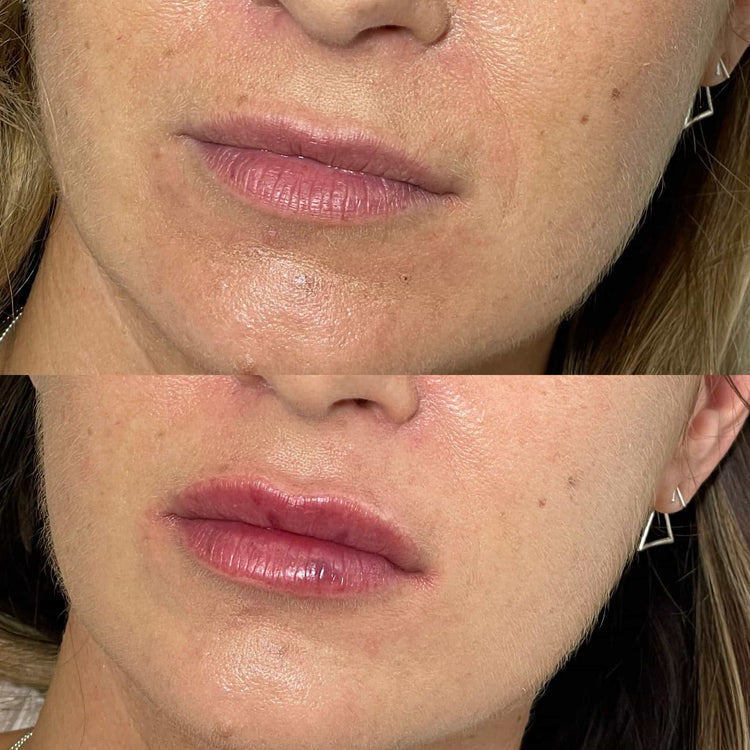Understanding Facial Asymmetry
Facial asymmetry is a common occurrence, with variations in features like cheekbones, brows, and noses being natural to most individuals. While some degree of asymmetry is perfectly normal, imbalances that are pronounced or cause distress can lead individuals to seek treatments for correction.
Causes of Facial Asymmetry
Understanding facial asymmetry begins with recognizing that subtle differences between the left and right sides of a face are common and often unnoticeable.
Numerous factors contribute to facial asymmetry, ranging from genetic predisposition during development to acquired conditions or injuries later in life.
Developmental factors like prenatal positioning in the womb can influence facial growth patterns, leading to minor asymmetries. Bone structure variations, muscle imbalances, and differences in fat distribution can further contribute to these irregularities.
Acquired causes include trauma, infections, or even habits like chewing on one side of the mouth, which can lead to shifts in jaw alignment or muscle development over time.
Types of Asymmetry
Types of facial asymmetry encompass a range of variations. Some common types include skeletal asymmetry, where there are differences in the size and shape of bones; muscular asymmetry, arising from unequal muscle development or tone; and soft tissue asymmetry, resulting from imbalances in fat distribution or skin folds.
These variations can manifest as subtle differences in the position of features like eyebrows, eyes, nose, or lips. In some cases, asymmetry may be more pronounced, affecting jaw alignment or creating noticeable discrepancies between the left and right sides of the face.
Filler Dissolving Treatment for Addressing Asymmetry
For those seeking to correct facial asymmetry, filler dissolving treatment presents a potential solution. This non-surgical procedure involves breaking down hyaluronic acid fillers previously used for volumization or contouring. By strategically dissolving excess filler in one side of the face, practitioners aim to restore balance and symmetry.
Mechanism of Action
Filler dissolving treatment works by utilizing an enzyme called hyaluronidase. Hyaluronidase is specifically designed to break down hyaluronic acid, the primary ingredient in many dermal fillers. When injected into areas where excessive filler has been placed, hyaluronidase systematically degrades the hyaluronic acid molecules, gradually dissolving the filler and restoring natural contours.
The effectiveness of filler dissolving treatment for addressing asymmetry depends on several factors, including the type and amount of filler used previously, the nature and extent of the asymmetry, and individual patient responses.
Procedure and Timeline
Filler dissolving treatment can be an effective solution for addressing mild to moderate facial asymmetry caused by overcorrection or placement issues with hyaluronic acid fillers.
The procedure typically involves injecting hyaluronidase, an enzyme that breaks down hyaluronic acid, into the areas where excess filler is causing asymmetry.
The treatment can take anywhere from a few minutes to an hour, depending on the extent of correction needed.
Results are often noticeable within days to weeks as the dissolved filler gradually reabsorbs into the body. Multiple treatments may be required for optimal results.
It’s important to note that filler dissolving treatment is not suitable for all types of facial asymmetry, such as skeletal or muscular imbalances.
Consultation with a qualified and experienced practitioner is essential to determine if filler dissolving treatment is an appropriate option and to develop a personalized treatment plan.

Candidates and Suitability
Filler dissolving treatment can be an effective solution for addressing mild to moderate facial asymmetry caused by overcorrection or placement issues with hyaluronic acid fillers.
This non-surgical procedure utilizes hyaluronidase, an enzyme that breaks down hyaluronic acid, the primary ingredient in many dermal fillers.
Hyaluronidase is injected into areas where excess filler is causing asymmetry, leading to the gradual dissolution of the filler and restoration of natural contours.
Ideal candidates for filler dissolving treatment typically have asymmetry stemming from overfilled areas or uneven distribution of hyaluronic acid fillers. They should also have realistic expectations about the treatment’s limitations.
It’s important to remember that filler dissolving treatment is not suitable for all types of facial asymmetry.
Skeletal or muscular imbalances, which are structural rather than volume-based issues, cannot be corrected with this method.

Consultation with a qualified and experienced practitioner is crucial to determine if filler dissolving treatment is an appropriate option and to develop a personalized treatment plan.
Effectiveness and Results
When it comes to addressing facial asymmetry, numerous options exist. For individuals who have sought augmentation using hyaluronic acid fillers but now find themselves with imbalances or overcorrection, filler dissolving treatment presents a viable solution. This non-surgical procedure aims to restore symmetry by strategically breaking down excess filler in targeted areas, allowing for a more balanced and natural appearance.
Success Rates and Patient Satisfaction
The effectiveness of filler dissolving treatment for addressing facial asymmetry varies depending on several factors. The type and amount of filler used previously, the nature and extent of the asymmetry, and individual patient responses all play a role in determining the outcome.
- Success rates for filler dissolving treatment are generally high for mild to moderate asymmetries caused by overfilled areas or uneven distribution of hyaluronic acid fillers.
- Patient satisfaction with the results is also typically good, as long as expectations are realistic.
- However, it’s important to note that filler dissolving treatment is not a suitable solution for all types of facial asymmetry.
Skeletal or muscular imbalances, which are structural rather than volume-based issues, cannot be corrected with this method.
Duration of Results
The duration of results from filler dissolving treatment varies depending on individual factors and the amount of filler dissolved. Results are generally temporary as hyaluronic acid is naturally broken down by the body over time.
In most cases, results last for several months to a year before the area may require repeat treatments or additional filler adjustments.
The body’s natural metabolic processes contribute to the gradual resorption of dissolved hyaluronic acid.
Factors Affecting Effectiveness
The effectiveness of filler dissolving treatment for addressing asymmetry depends on several factors.
- Type and amount of filler used previously
- Nature and extent of the asymmetry
- Individual patient responses
Filler dissolving treatment is most effective for mild to moderate asymmetries caused by overcorrection or uneven distribution of hyaluronic acid fillers.
For these cases, success rates are generally high, and patients often express satisfaction with the results.
However, it’s important to remember that filler dissolving treatment is not a cure-all for facial asymmetry.
It is not suitable for addressing skeletal or muscular imbalances, which require different treatment approaches.

Risks and Complications
Like any medical procedure, filler dissolving treatment carries certain risks and complications. Although generally considered safe, potential side effects may include swelling, bruising, redness, itching, and tenderness at the injection site. In rare instances, more serious complications such as infection, allergic reactions, or changes in skin pigmentation can occur. It is crucial to consult with a qualified and experienced practitioner to assess your individual risk factors and discuss any concerns you may have before undergoing treatment.
Potential Side Effects
Like any medical procedure, filler dissolving treatment carries certain risks and complications. Although generally considered safe, potential side effects may include swelling, bruising, redness, itching, and tenderness at the injection site.
In rare instances, more serious complications such as infection, allergic reactions, or changes in skin pigmentation can occur.
It is crucial to consult with a qualified and experienced practitioner to assess your individual risk factors and discuss any concerns you may have before undergoing treatment.
Infection Risks
Like any medical procedure, filler dissolving treatment carries certain risks and complications. Although generally considered safe, potential side effects may include swelling, bruising, redness, itching, and tenderness at the injection site.
- In rare instances, more serious complications such as infection, allergic reactions, or changes in skin pigmentation can occur.
It is crucial to consult with a qualified and experienced practitioner to assess your individual risk factors and discuss any concerns you may have before undergoing treatment.
Allergic Reactions
Like any medical procedure, filler dissolving treatment carries certain risks and complications. Although generally considered safe, potential side effects may include swelling, bruising, redness, itching, and tenderness at the injection site.
In rare instances, more serious complications such as infection, allergic reactions, or changes in skin pigmentation can occur.
It is crucial to consult with a qualified and experienced practitioner to assess your individual risk factors and discuss any concerns you may have before undergoing treatment.
Alternatives to Filler Dissolving Treatment
For those seeking to correct facial asymmetry, alternatives to filler dissolving treatment exist. Depending on the cause and severity of the asymmetry, other options might be more suitable or effective.
Surgical Options
Surgical options are available for addressing more severe or complex cases of facial asymmetry.
These procedures often involve reshaping or repositioning bones, muscles, or tissues to achieve a balanced appearance.
Some common surgical approaches include:
- Orthognathic surgery: This procedure involves correcting jaw misalignment and bite problems, which can contribute to facial asymmetry.
- Facial implants: Implants can be used to augment specific areas of the face, such as cheekbones or chin, to improve symmetry.
- Muscle repositioning: For asymmetry caused by muscle imbalances, surgeons may perform procedures to redistribute or reattach muscles.
- Bone grafts: In cases where bone structure contributes to asymmetry, bone grafts can be used to reshape or augment deficient areas.
The choice of surgical procedure will depend on the individual’s specific needs and the underlying cause of their facial asymmetry.
Other Injectable Treatments
For those seeking to correct facial asymmetry, alternatives to filler dissolving treatment exist. Depending on the cause and severity of the asymmetry, other options might be more suitable or effective.
Other injectable treatments can be used to address certain types of asymmetry.
- Botox: Botox injections can be used to relax muscles that may be contributing to facial asymmetry. For example, it can help even out the appearance of eyebrows that are uneven or drooping.
- Dermal Fillers:** Beyond volumizing and contouring, dermal fillers can also be strategically placed to address specific asymmetries. For instance, a small amount of filler might be used to subtly lift a sagging corner of the mouth or augment a slightly underdeveloped cheekbone.
Conclusion**
Filler dissolving treatment can offer a solution for mild to moderate facial asymmetry caused by overcorrection or uneven distribution of hyaluronic acid fillers. However, it is not a universal solution and its effectiveness depends on factors such as the type and amount of filler used previously, the nature and extent of the asymmetry, and individual patient responses.
For optimal results, consultation with a qualified and experienced practitioner is essential to determine if filler dissolving treatment is appropriate and to develop a personalized treatment plan.
- Polynucleotides Injectables Near Gatton, Surrey - November 3, 2025
- Obagi Blue Peel Radiance Peel Near Worplesdon, Surrey - October 31, 2025
- Obagi Blue Peel Radiance Peel Near Kingston Upon Thames, Surrey - October 28, 2025
